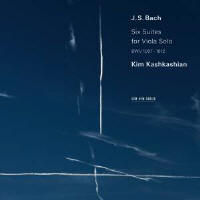Texte paru dans: / Appeared in: |
|
|
Outil de traduction ~ (Très approximatif) |
|
|
Reviewer: Raymond
Tuttle ECM’s cover identifies these as Bach’s “Six Suites for Viola Solo,” but the inclusion of BWV numbers directly underneath clues us in that these are the Cello Suites, not a set of newly discovered works for viola! Playing this music on a viola is not a new thing; Bach might have done so himself. Violist Lillian Fuchs recorded a complete pre-stereo set in the 1950s, and many violists since then have followed her example. (Most of them are women—why?) Many young violists, I understand, play Bach’s suites as part of their musical upbringing. The cello and the viola are tuned in the same way (but an octave apart), so one can barely call these “transcriptions.” The conversion from cello to viola is straightforward. The music itself, however, and playing it well, are much thornier challenges! Kim Kashkashian calls Bach “a true and faithful companion who patiently provides a merciless and transparent reflection of one’s failings in vision and simultaneously gives the deepest of comfort in all circumstances.” Right on. I suppose it was only a matter of time before Kashkashian recorded these works, having played them in concert for decades. She goes so far as to play Suite No. 6 on a five-string viola. (Bach is believed to have composed this particular suite for a five-string cello, although it is not always played that way.) This new set is definitely competitive, as it testifies to Kashkashian’s seemingly limitless thoughtfulness and insight, as will as to her technical mastery. For comparison, I revisited a recording with Rivka Golani (CBC Musica Viva 1141). The first thing I noticed was how different the violas sound, from one recording to the other. The microphones on Golani’s recording are placed at a respectful distance from her viola, and the recording venue is quite reverberant—probably a church. Together, these two factors give the viola an isolated and somewhat lonely sound. Kashkashian’s viola is recorded much more closely, and there is much less air around the notes. The recording venue was the American Academy of Arts and Letters in New York. Golani tends to play these suites more Romantically, favoring long legato lines. She also plays faster (not consistently, however) which helps those long, legato lines to stay buoyant and not sag under their own weight. Although she is playing on a modern instrument, Kashkashian is more willing than Golani to use period style. She subdivides phrases more liberally than Golani, although the result never feels choppy or short-breathed. It, too, never sags. All in all, Kashkashian’s interpretations are intelligent, and more objective than Golani’s. They also are a bit more colorful. On the other hand, I like Golani’s vulnerability, and the added atmosphere provided by the recording venue. She is an idealist. Kashkashian is more of a pragmatist, and we need pragmatists as much as we need optimists! | |
|
|
|
|
|
|
|
Cliquez l'un ou l'autre
bouton pour découvrir bien d'autres critiques de CD |
|


/logos/accueil_home.gif)
/logos/Savall.gif)
/logos/Recompenses.gif)